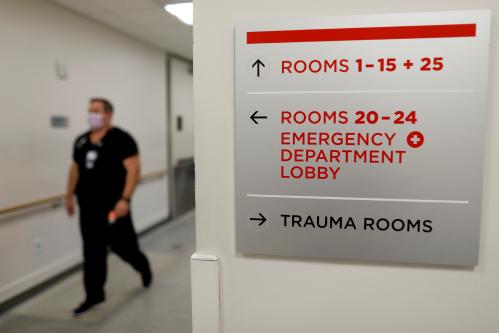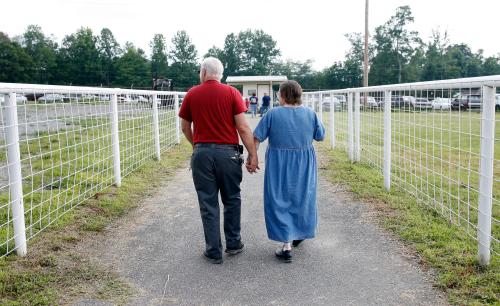This analysis is part of the USC-Brookings Schaeffer Initiative for Health Policy, which is a partnership between the Center for Health Policy at Brookings and the University of Southern California Schaeffer Center for Health Policy & Economics. The Initiative aims to inform the national health care debate with rigorous, evidence-based analysis leading to practical recommendations using the collaborative strengths of USC and Brookings.
On July 25th, the Centers for Medicare and Medicaid Services (CMS) proposed an important change to Medicare’s hospital outpatient prospective payment system (OPPS). Under the proposed policy, Medicare would pay the same amount for certain common types of visits to “off-campus” hospital outpatient departments (HOPDs) as it would for the same type of visit to a physician’s office.[1] This rule change would result in significant savings for Medicare and its beneficiaries and foster greater competition in the physician services market, although hospitals would not welcome this reduction in their payments.
While the proposed rules are an important step in the right direction, the CMS proposal applies to a relatively limited set of services. We believe that site-neutral payment should ultimately be applied to a much broader set of clinical services, similar to those included in the 2014 MedPAC recommendations, and at both off-campus and on-campus HOPDs, as well as at ambulatory surgery centers. We do not have the legal expertise to evaluate how much progress CMS could make on its own and how much would require legislation, but we strongly believe that site neutrality is good policy for Medicare, Medicare beneficiaries, and the health care system as a whole. We therefore recommend that CMS and, if necessary, Congress, move expeditiously to implement site-neutral payment as broadly as possible in the Medicare program.
Site-of-Service Payment Differentials are a Major Problem
Historically, Medicare has typically paid a higher rate for the same service when performed at a HOPD rather than a physician’s office. For instance, at an off-campus HOPD built before November 2015, Medicare paid about $158 for a clinic visit for an established patient in 2017, whereas it paid about $74 for a similar visit in a physician’s office. In this instance, if the visit occurred in the physician’s office, Medicare would save $67 and the beneficiary would save $17 in coinsurance.[2]
Many policymakers, including CMS Administrator Seema Verma, correctly see these disparate payment rates as wasteful because physician offices can deliver many services just as safely at lower cost to the program. Additionally, site of service payment differentials create an incentive for hospitals to acquire physicians’ practices and rebrand them as HOPDs, causing the magnitude of this problem to grow over time.
Increased hospital ownership of physician practices can also drive up costs for private payers by increasing the prices they pay for physician services and possibly hospital services as well. It is not fully understood why hospital ownership of physician practices increases prices, but multiple channels appear plausible. Most directly, private payers, like Medicare, commonly pay more for the same service when it is delivered in an HOPD rather than a physician’s office. Additionally, bringing independent physician practices together under the hospital’s ownership likely enables the hospital to negotiate higher prices for physician services because it has greater leverage than the practices had individually. And hospital-owned physician practices are far more likely to refer their patients to the hospital and its affiliated specialists, which may weaken insurers’ ability to steer patients to other, lower-cost providers.
While site-of-service payment differentials are not the only factor driving hospitals to acquire physician practices, they likely do play some role and are perhaps the most straightforward to address. Embracing a policy of site-neutral payments could thus save Medicare a considerable sum of money while simultaneously generating savings for private payers by addressing one driver of provider consolidation.
CMS’ proposed OPPS rule changes are not the first move towards site-neutral payment in Medicare in recent years. The Bipartisan Budget Act of 2015 (BBA) required Medicare to pay for services delivered at newly established off-campus HOPDs using rates based on the physician fee schedule, rather than the OPPS, thereby reducing the incentive for hospitals to acquire physician practices identified above.[3] At the time, the Congressional Budget Office (CBO) projected that this provision would save Medicare $9.3 billion over ten years.
However, this provision (and subsequent amendments to the provision) exempted certain sites of care, including dedicated emergency departments and all ambulatory surgery centers, as well as on-campus outpatient departments and off-campus physician offices that billed for services, rendered services, or were being built prior to November 2nd, 2015. These exemptions meant that hospital still have strong incentives to add more physicians to on-campus clinics and those off-campus clinics that had been “grandfathered” under the BBA, including by purchasing physician practices and relocating them to these existing facilities. The exemption for dedicated emergency departments also creates a perverse incentive to build more standalone emergency departments (which generally include outpatient clinics) in order to capture higher payment rates. Thus, while the BBA was an important step in the right direction, it preserved much of the excess spending that had provided the impetus for reform, while preserving many avenues—and strong incentives—to shift physician office services into the HOPD setting.
CMS’ Proposed Policy is a Positive Step, but More is Required
The new changes to the OPPS proposed by CMS would address some of the shortcomings of the BBA. Specifically, the CMS proposal would apply rates based on the physician fee schedule to clinic visits at off-campus HOPDs that were grandfathered under the BBA, thereby aligning these payment rates with the rates for non-grandfathered HOPDs under the BBA. [4] CMS projects that this step toward extending site-neutrality would reduce the cost of care by $760 million in 2019 alone, with approximately 20 percent of that amount accruing in the form of lower coinsurance.
While these changes would surely be beneficial, we believe policymakers should go further towards achieving site neutrality. To begin with, we recommend eliminating the grandfathering of higher OPPS payments to existing off-campus HOPDs for all services, not just clinic visits. Removing this exception for all services, as was proposed in the Trump Administration’s fiscal year 2019 budget, would generate considerable additional savings. The Administration estimated these savings at nearly $34 billion over the next ten years (2019-2028), while CBO estimated smaller, but still significant, savings of $13.9 billion over the same time period. These estimates indicate that broadening CMS’ proposal in this way would likely generate significant additional savings.
Policymakers should also align the payments to on-campus HOPDs with those paid to freestanding physician practices where possible. In a 2017 report, the Medicare Payment Advisory Commission (MedPAC) estimated that instituting full payment neutrality for clinic visits at both on-campus and off-campus HOPDs would save Medicare $2 billion per year, which indicates that expanding CMS’ proposal in this way would also increase savings considerably.
Ideally, however, policymakers would move toward payment neutrality for all services delivered in on-campus HOPDs that can be safely delivered outside of a hospital. In 2013, MedPAC identified 24 Ambulatory Payment Classifications (APCs) for which quality was equivalent across sites of service and for which there were no additional advantages for performing in a hospital setting. They also identified 42 APCs for which quality was comparable but for which hospital settings provided advantages that justified a slightly higher facility fee. Broadly speaking, these were services that sometimes benefited from hospitals’ unique capabilities, like 24-hour operations or the availability of back-up and specialists, but did not absolutely need to be performed in a hospital setting. Consequently, MedPAC recommended equalizing the payments for the 24 equivalent services and reducing the differential for the comparable 42. Recent estimates of the cost savings of this type of broader policy are not available, but could be considerable.
As noted earlier, moving toward greater site neutrality would have spillover benefits in private insurance by reducing hospitals’ incentives to acquire physician practices, which may enable private insurers to secure better prices. This effect could be magnified if Medicare’s policy change emboldens private insurers to also curtail facility fees.
Conclusion
We applaud CMS for its proposal to expand site-neutral payment in Medicare, but much more remains to be done. For that reason, we are encouraged that CMS’ proposal solicited comment on ways it could further expand site-neutral payment in future rulemaking, and we encourage CMS to be as aggressive as it can be in the years to come. We would also encourage Congress to consider further action in this area, as Congress can likely implement more comprehensive site-neutral payment reforms—and implement them more quickly—than CMS can on its own.
[1] “On-campus” refers to those departments within 250 yards of main hospital buildings or a remote hospital location. All other departments are considered “off-campus.”
[2] Beneficiaries without supplemental coverage will benefit directly from lower coinsurance. In other cases, the benefits will accrue to whoever finances beneficiaries’ supplemental coverage, which may be beneficiaries themselves, their current or former employers, or state and federal governments.
[3]Technically, the BBA requires that the relevant services be paid for “under the applicable payment system.” In almost all cases, that system is the physician fee schedule. For operational reasons, CMS has not literally paid the existing physician fee schedule rates for these services. Rather, it has applied a proportional reduction to OPPS rates designed to ensure that the payment rates for services delivered at non-grandfathered off-campus HOPDs match physician fee schedule rates on average.
[4] For our purposes, “clinic visits” refers to all outpatient evaluation and management services.













Commentary
CMS’ positive step on site-neutral payments and the case for going further
August 10, 2018